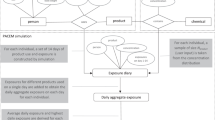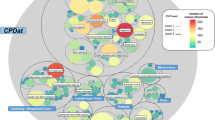Abstract
Exposure scenarios (ES) under REACH (Registration, Evaluation, and Authorisation of Chemicals; new EU legislation) aim to describe safe conditions of product and substance use. Both operational conditions and risk management measures (RMMs) are part of the ES. For consumer use of chemicals, one of the challenges will be to identify all of the consumer uses of a given chemical and then quantify the exposure derived from each of them. Product use categories can be established to identify in a systematic fashion how products are used. These product categories comprise products that are used similarly (e.g. paints, adhesives). They deliver information about product use characteristics, and provide an easy-to-handle tool for exchanging standardised information. For practical reasons, broad ES will have to be developed, which cover a wide range of products and use. The challenge will be to define them broadly, but not in a way that they provide such an overestimation of exposure that a next iteration or a more complex model is always needed. Tiered and targeted approaches for estimation of exposure at the right level of detail may offer the best solution. RMMs relevant for consumers include those inherent to product design (controllable) and those that are communicated to consumers as directions for use (non-controllable). Quantification of the effect of non-controllable RMMs on consumer exposure can prove to be difficult. REACH requires aggregation of exposure from all relevant identified sources. Development of appropriate methodology for realistic aggregation of exposure will be no small challenge and will likely require probabilistic approaches and comprehensive databases on populations' habits, practices and behaviours. REACH regulation aims at controlling the use of chemicals so that exposure to every chemical can be demonstrated to be safe for consumers, workers, and the environment when considered separately, but also when considered in an integrated way. This integration will be another substantial challenge for the future.
This is a preview of subscription content, access via your institution
Access options
Subscribe to this journal
Receive 6 print issues and online access
$259.00 per year
only $43.17 per issue
Buy this article
- Purchase on Springer Link
- Instant access to full article PDF
Prices may be subject to local taxes which are calculated during checkout


Similar content being viewed by others
References
Bickers D.R., Calow P., Greim H.A., Hanifin J.M., Rogers A.E., Saurat J.H., Spes G.I., Smith R.L., and Tagami H. The safety assessment of fragrance materials. Regul Toxicol Pharmacol 2003: 37: 218.
Cadby P.A., Troy W.R., and Vey M.G. Consumer exposure to fragrance ingredients: providing estimates for safety evaluation. Regul Toxicol Pharmacol 2002: 36: 246.
Commission of the European Communities. 2006 Regulation (EC) No. 1907/2006 of the European Parliament and of the Council of 18 December 2006 concerning the Registration, Evaluation, Authorisation and Restriction of Chemicals (REACH), establishing a European Chemicals Agency, amending Directive 1999/45/EC and repealing Council Regulation (EEC) No. 793/93 and Commission Regulation (EC) No 1488/94 as well as Council Directive 76/769/EEC and Commission Directives 91/155/EEC, 93/67/EEC, 93/105/EC and 2000/21/EC. Off J Eur Union, L 396/1 of 30.12.2006.
European Chemicals Bureau. (2005a) WP 1: Development of the concept of exposure scenarios. Scoping study — Final report, “Technical Guidance Document on preparing the Chemical Safety Report under REACH — Scoping Study — Phase 1 A (REACH Implementation Project 3.2-1A)”, Service Contract Number 22551-2004-12 F1SC ISP BE http://ecb.jrc.it/REACH/.
European Chemicals Bureau. (2005b) WP 3 — 1b: Technical Guidance Document on preparing the Chemical Safety Report under REACH — Preliminary Guidance Document on preparing the Chemical Safety Assessment under REACH — Phase 1B (REACH Implementation Project 3.2-1B)” Service Contract Number 22552-2004-12 F1SC ISP BE http://ecb.jrc.it/REACH/.
Ford R.A., Dormeyer B., Easterday O., Maier K., and Middletown J. Criteria for development of a database for safety evaluation of fragrance ingredients. Regul Toxicol Pharmacol 2000: 31: 166.
Health Canada. A proposed integrated framework for the health-related components of categorization of the Domestic Substances List under CEPA 1999, 2005: http://www.hc-sc.gc.ca/ewh-semt/alt_formats/hecs-esc/pdf/contaminants/existsub/framework-int-cadre_e.pdf.
Heinemeyer G., and Hahn A. Use of product databases for risk assessment purposes. Tox Appl Pharmacol 2005: 207: S636–S644.
Heinemeyer G., Lindtner O., Scholz R., and Rüdiger T. Evaluation of behaviour of consumers for exposure assessment by questionnaire studies. Abstract book, International Conference of Environmental Epidemiology and Exposure. Paris, 2006.
Kovacs D.C, Small M.J., Davidson C.I., and Fischhoff B. Behavioral factors affecting exposure potential for household cleaning products. J Exp Anal Env Epidem 1997: 7: 505–520.
Sanderson H., et al. Exposure and prioritization-Human screening data and methods for high production volume chemicals in consumer products: Amine oxides a case study. Risk Anal 2006: 26 (6): 1637–1657.
SDA The Soap and Detergent Association. 2005 Exposure and Risk Screening Methods for Consumer Product Ingredients. The SDA, 1500K Street, NW, Suite 300, Washington, DC, USA, 2005.
WHO/IPCS. IPCS Risk Assessment Terminology, Part II: IPCS Glossary of Key Exposure Assessment Terminology, 2004: http://www.who.int/ipcs/methods/harmonization/areas/ipcsterminologyparts1and2.pdf.
WHO/IPCS. Principles of Characterizing and Applying Human Exposure Models, 2005: http://whqlibdoc.who.int/publications/2005/9241563117_eng.pdf.
Author information
Authors and Affiliations
Corresponding author
Rights and permissions
About this article
Cite this article
Van Engelen, J., Heinemeyer, G. & Rodriguez, C. Consumer exposure scenarios: development, challenges and possible solutions. J Expo Sci Environ Epidemiol 17 (Suppl 1), S26–S33 (2007). https://doi.org/10.1038/sj.jes.7500577
Received:
Accepted:
Published:
Issue Date:
DOI: https://doi.org/10.1038/sj.jes.7500577
Keywords
This article is cited by
-
Consumer product chemical weight fractions from ingredient lists
Journal of Exposure Science & Environmental Epidemiology (2018)
-
Passive sampling methods to determine household and personal care product use
Journal of Exposure Science & Environmental Epidemiology (2012)



